Ancient Aliens on the Moon (32 page)
Read Ancient Aliens on the Moon Online
Authors: Mike Bara

Closer view of the “Factory.” Note triangular bunkers and “access roads.”
Now, completely setting aside for the moment the strange lack of “spew” from such a large impact, my eyes were drawn to the area to the right of Hortensius between it and Hortensius C, the smaller (about 7 km diameter) crater at the image’s right edge. In here, I noted (as Steve had) some very significant geometry—and some overt structures.
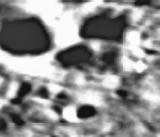
The bunkers in high contrast.
This stunning region is about 4 x 3 kilometers, judging by the size of Hortensius C. It is dominated by triangular “hanger doors” leading to semi-recessed bunker like structures, and a stunning black box shaped object the size of a 10 story building. In addition, the pronounced right angle pattern in the foreground is reminiscent of barely covered tunnel network. There is also a striking symmetry in the exposed areas (the T-shaped feature behind the building for instance).
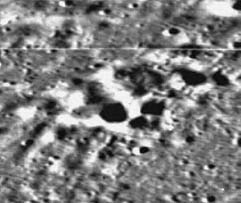
High-contrast view of the Factory.
What struck me first were rows and rows of archways and entrances that were at different levels of the structure. There seemed to be access roads, entrances and hangar doors all along this area. Contrast enhanced close-ups showed some even stranger structures, pipes and tube networks all around the area.
This series of raised, parallel triangular openings are recessed into the surrounding terrain, and compare favorably to the camouflaged bunkers here on Earth. This reinforces the impression of a factory or storage complex. Note also the straight line behind the first set of “bunkers.” Organized facilities display regular, repeating patterns and identical features over wide distances. Natural formations are far more random.
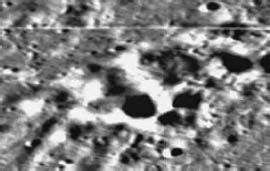
Black object (center) is the “Lincoln Memorial.”
The shadows cast by the bunkers are inconsistent with oval cratering caused by ejecta impacts. To say this arrangement of objects is anomalous is a wild understatement. They are flatly inexplicable in a currently accepted or theorized geologic model.
There are parallel terraces all along the right side of this Factory and perpendicular striations (access roads?) around the bunkers. Conceivably, the underlying tunnel network could be lava tubes formed in the ancient past similar to riles and ridges seen in other regions of the Moon. However, it should also be observed that such tubes have been proposed as ideal locations for eventual human bases on the lunar surface because they provide easily sealed off cavities with natural protection from the harsh radiation and temperature variations that would be encountered. This would make modified “natural” lava tubes an ideal place to hollow out a subsurface base of some kind.
Just above and behind “bunker row” is a large, dark object that appears to be sitting exposed on a plank of sorts above a dark opening. It has a large, rounded object on top of it that is casting a shadow on the main body below. The right part of the plank appears to be connected to the central complex by a dark, cylindrical object.

The “Lincoln Memorial.”
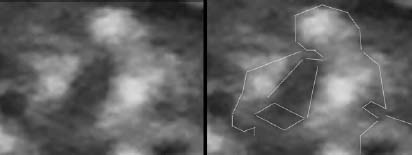
Marked up details of The “Lincoln Memorial.”
Quite simply, there is no conventional natural explanation for this set of objects. Indeed, there is no conceivable geologic process or even set of processes which can account for these structures. It certainly isn’t any kind of crater.
Notice that there is no discernible rim, and compare it with countless other examples of sharp edged impact regions across the lunar landscape. The “Lincoln Memorial” itself is a roughly cubic shape, with spherical nodes or buttresses at the base along the “plank”. Lincoln also seems to have a “head” that is approximately spherical and casting a vast shadow over his “chest.” To the right, a canister like object seems to be linking the “plank” to the main body of the facility. The “Truss” has cylindrical central body spanning the “plank” and the edge of the “terraces.” It is anchored at both ends by a half-slot shaped end cap which extends to the ground on each side. The archway underneath the cylindrical shape is plainly visible. This object would appear to be a support or reinforcing member holding the “plank” up.
Note the shadow cast beneath Lincoln seems to be a hollow area with no visible support for the structure. The plank itself would seem to be only thing holding the Memorial up.
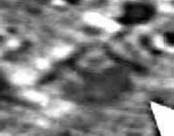
The Overhang.
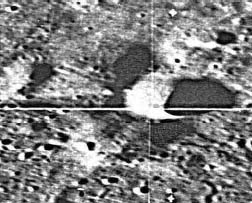
Crater with support struts and girders around it.
Ultra close-ups not only show the shadow cast by the head, but also what may be a rectangular platform beneath. This platform would be large enough to serve as a landing pad for a vehicle like the Lunar Module.
And there are other strange, architectural looking objects all over LO-III-123M. On the right side of the Factory complex is a dark opening with a disk-shaped object hanging over it.
Notice it is supported from the upper rear by a strut, and that the surrounding terrain seems to flow into the darkness below it, as if this were the entrance to an underground bunker or complex. Given its location adjacent to the “Factory”, this may indeed be precisely that. Note the generally square shape of the opening, and again the even symmetry of the both the “Overhang” itself and chasm it seems to guard. There is also a light, dome shaped node just beneath the “Overhang” in the darkened area which may be indicative of light (from the nearly directly overhead sun) creeping through thinned areas of the “Overhang” itself, or possibly of some form of self-luminescence. A final possibility is that the “Overhang” has a light source in its central disk and this is projecting downward. There certainly seems to be a rounded “something” in the dark area below the opening.
The last area I’ll cover from LO-III-123M is the area around the crater just east of (and adjacent to) the Factory. When I looked at the scans of the photographic negatives (which are much higher resolution than the current “high-res” scans on NASA websites) I was frankly, pretty astonished at what I saw. There, in a crater next to the Factory, was a bunch of structural debris.
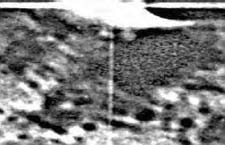
Close-up of a girder.
The crater itself is approximately two KM across and seems to be of the collapse variety. On closer inspection the area around it seems to consist of intersecting structural members barely poking through the regolith. They are very linear and have regularly spaced “lightening holes”, or dark areas, in them.
